Abstract
Reported are the prevalence of reproductive tract infections and their contribution to pelvic inflammatory disease (PID), as well as the seroprevalence of human immunodeficiency virus (HIV), among women living in three inner city wards of Mumbai, India. Women aged < or = 35 years were recruited and screened as cases if they had been admitted to hospital for gynaecological investigation for suspected PID (n = 151) or infertility (n = 295); controls were healthy fertile women attending for laparoscopic tubal ligation (n = 2433). The women were mainly of low socioeconomic status. A total of 59.4% were migrants and 14.9% of these came to Mumbai to seek treatment. Cases reported a history of adverse pregnancy outcomes significantly more often than controls, and 30.5% of suspected PID cases had previously undergone laparoscopic tubal ligation. At examination 24.2% of cases and 8.4% of controls had a vaginal discharge. Pelvic infection was confirmed in 42.0% of suspected PID cases and 14.6% of infertile cases for whom diagnostic laparoscopy was performed. The prevalence of sexually transmitted diseases was low: Chlamydia trachomatis was found in 0.2%; and Neisseria gonorrhoeae was cultured from the cervix in only four cases. Neither of these infections was detected in laparoscopic aspirates. The prevalence of HIV1/2 infections in unlinked samples was 1.9%. Sexually transmitted diseases were not major factors leading to gynaecological morbidity. Heterosexual spread of HIV infection to this population of married women is still relatively low but needs to be carefully monitored. The gynaecological morbidity detected may be a consequence of widespread use of invasive methods of fertility regulation.
Full text
PDF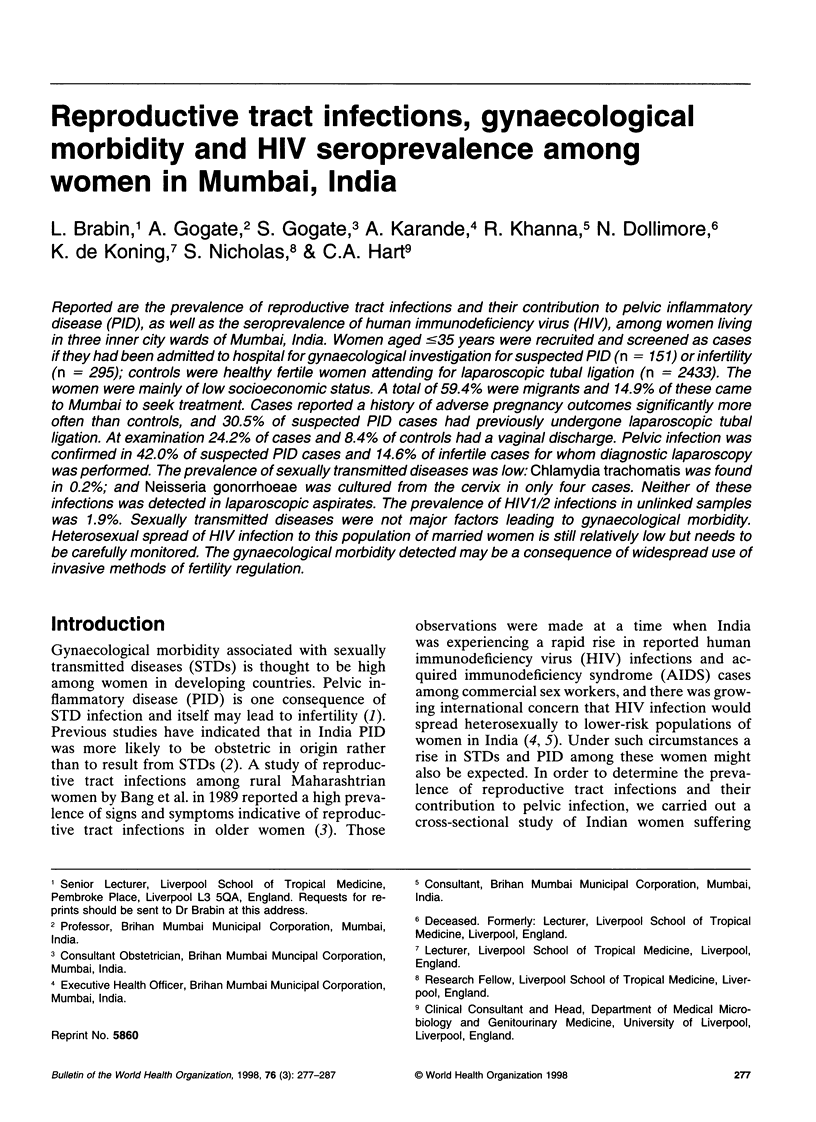
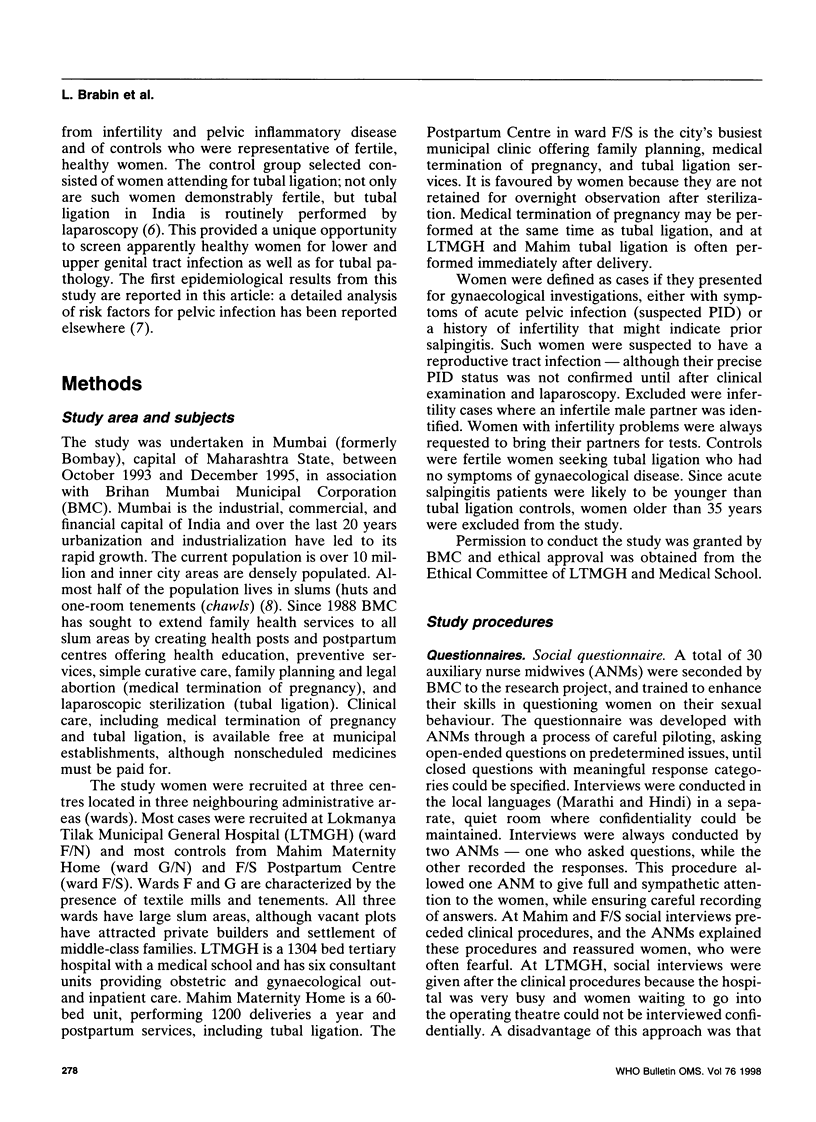
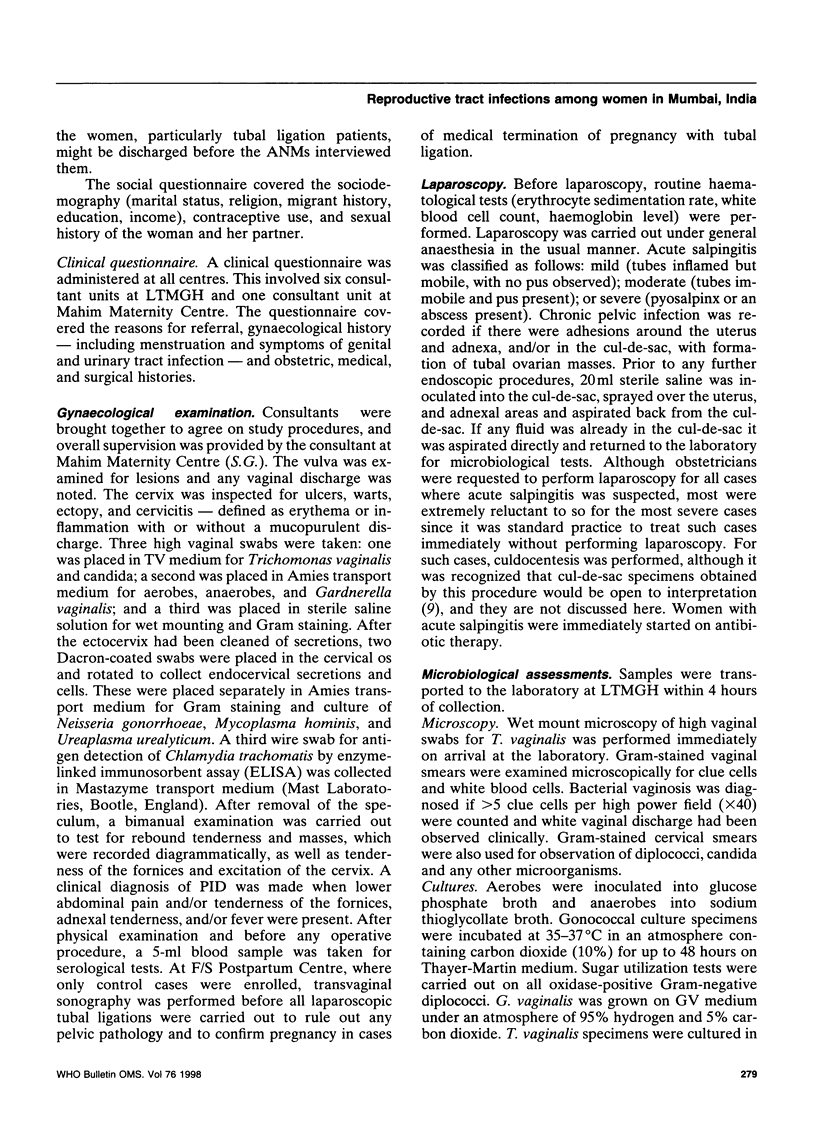
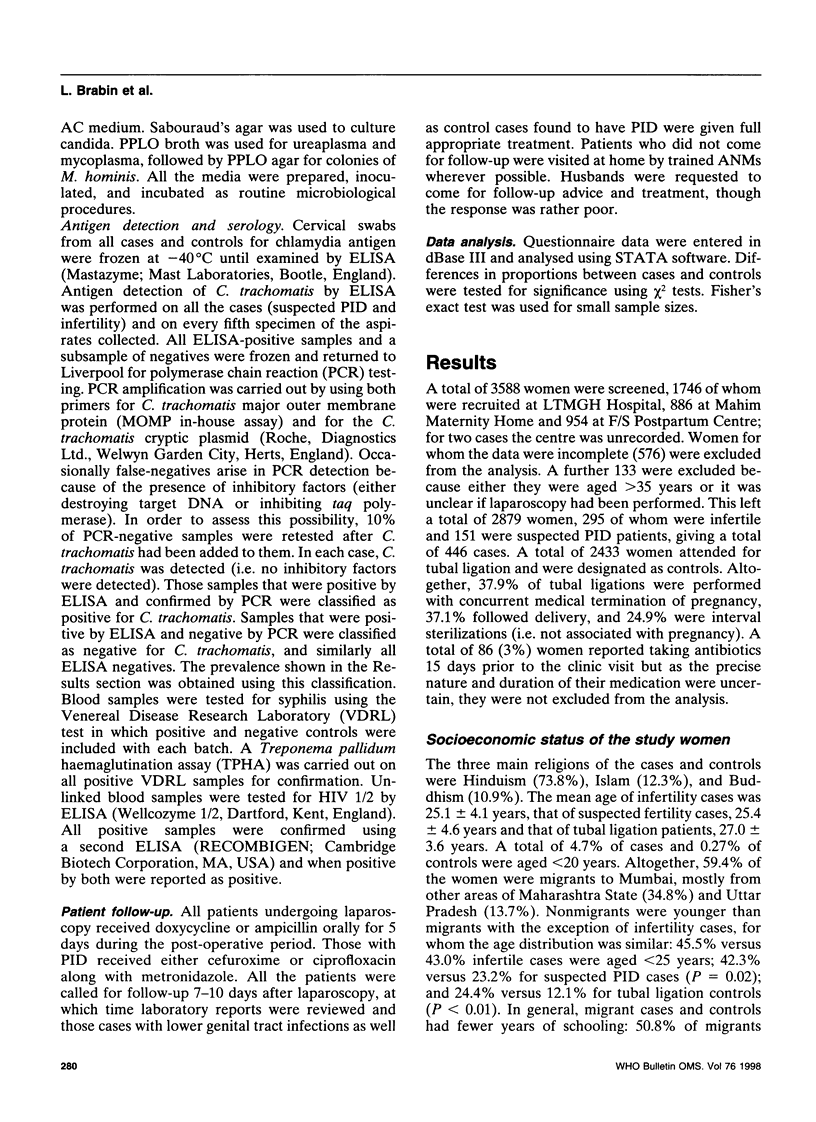
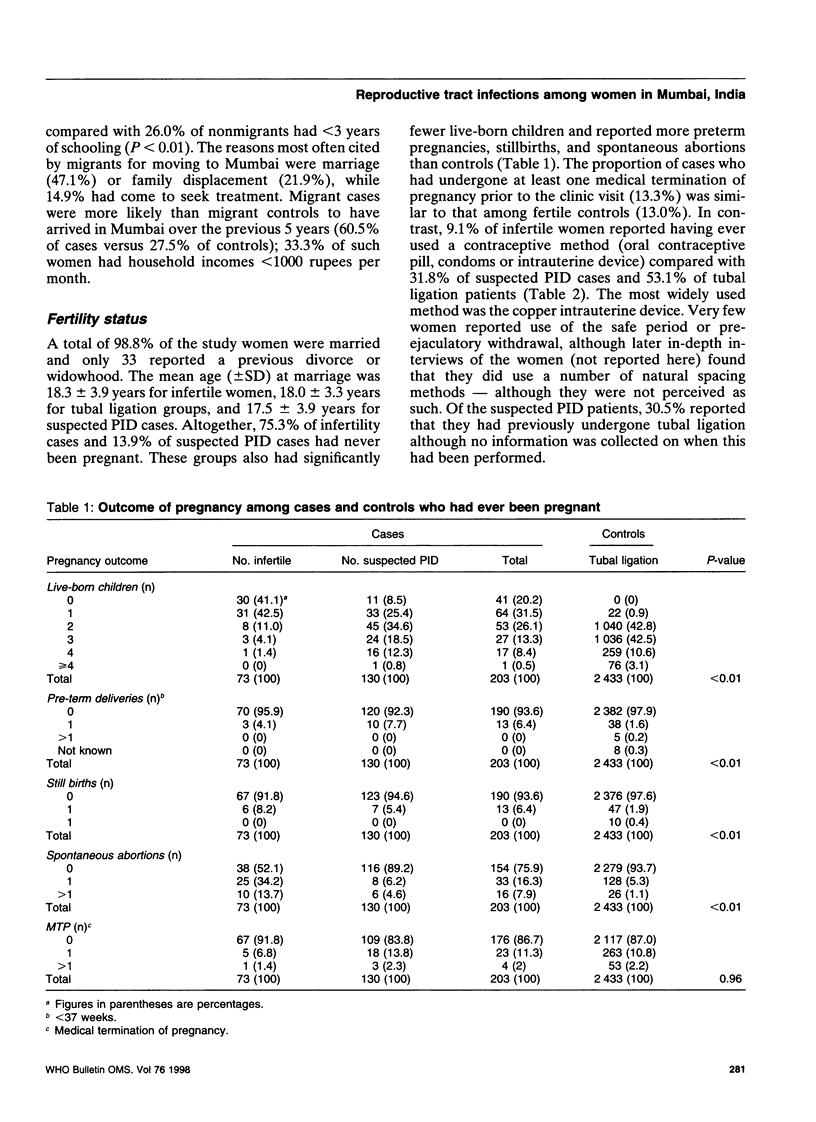
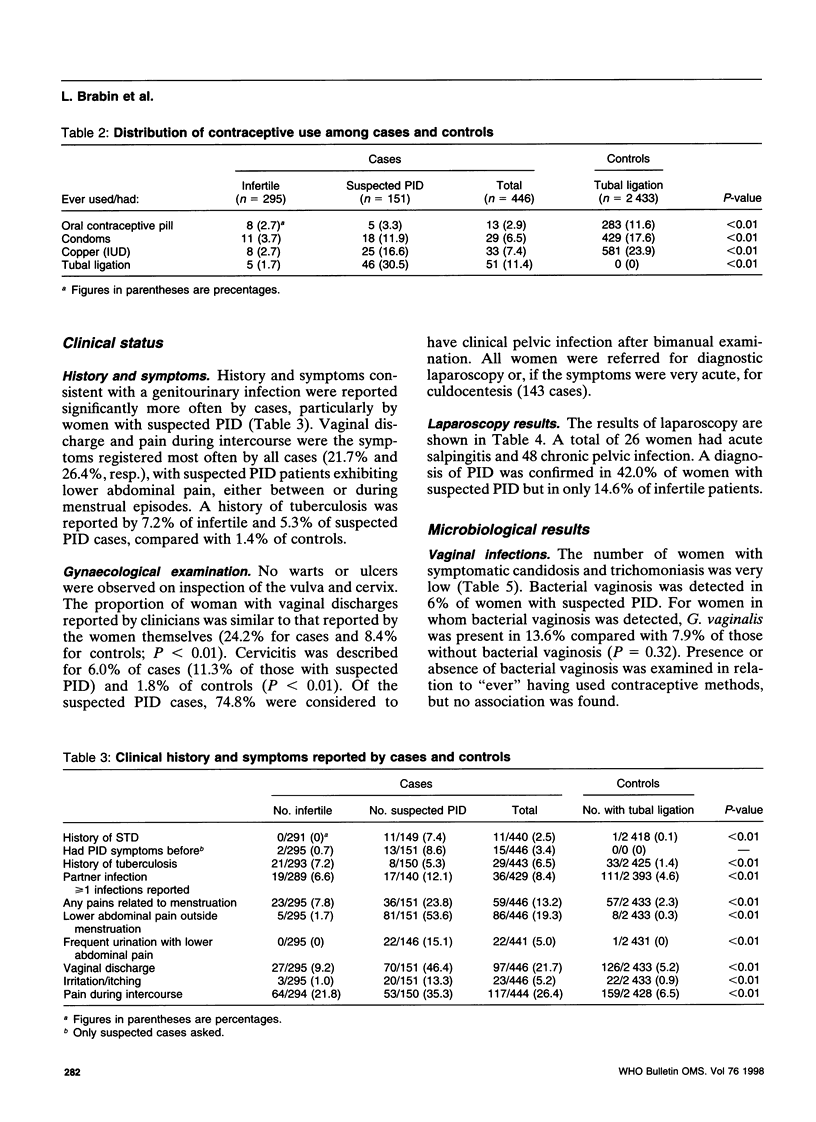
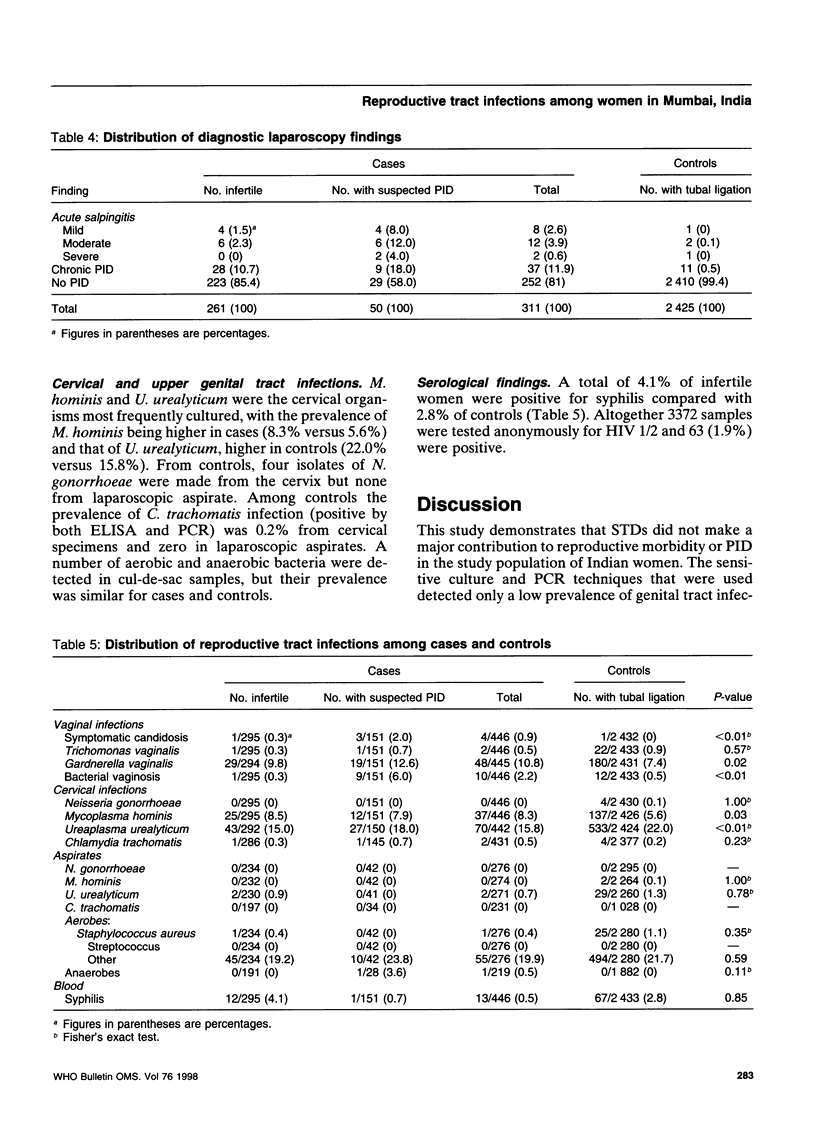
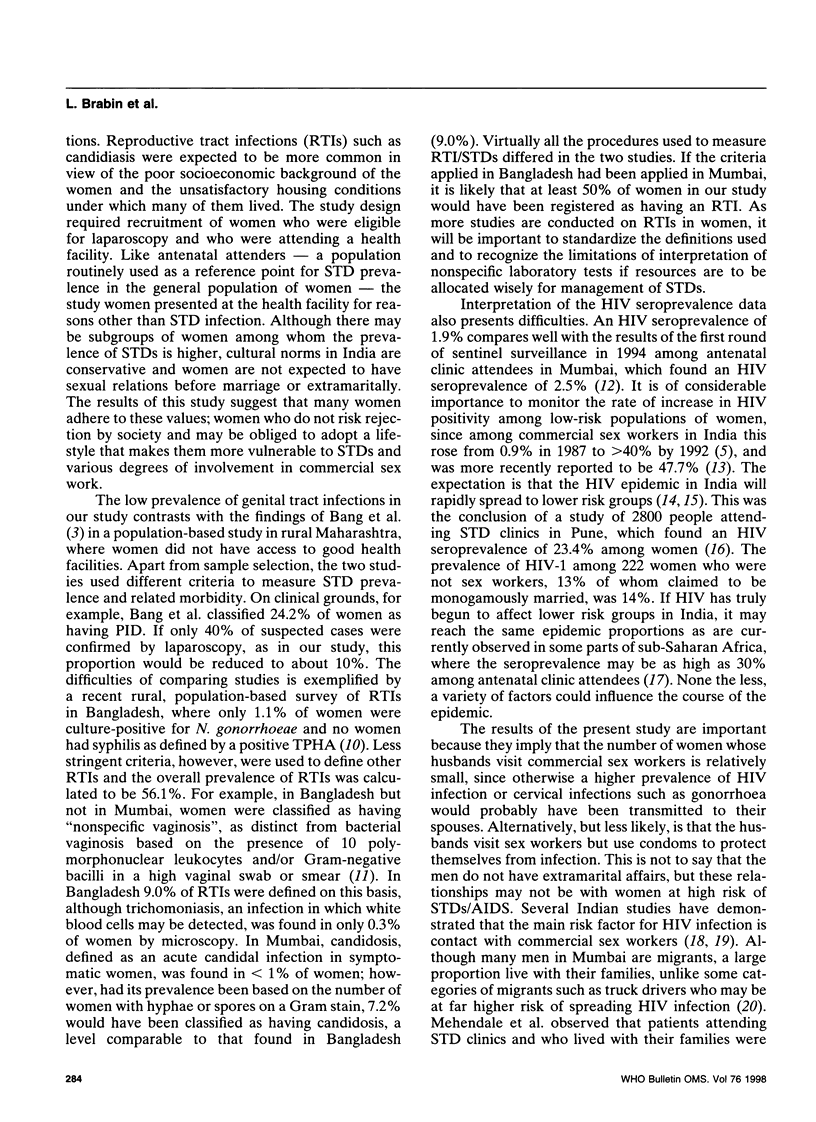
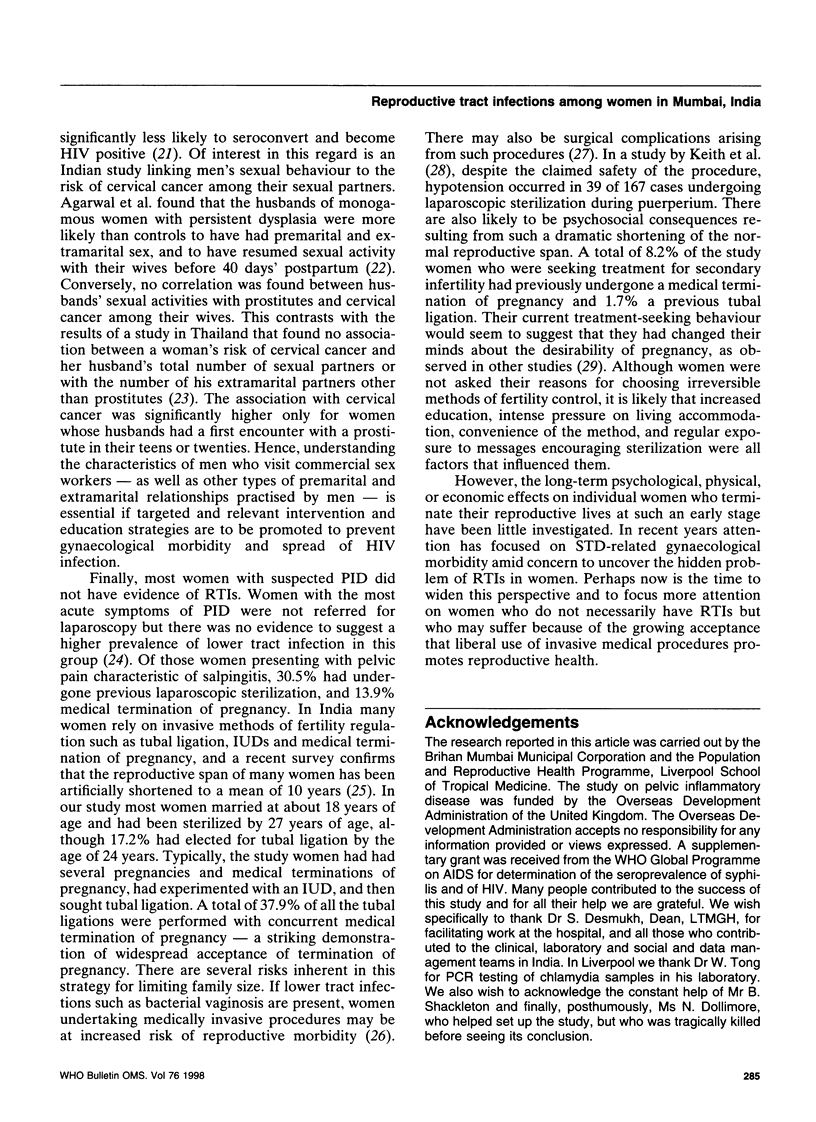
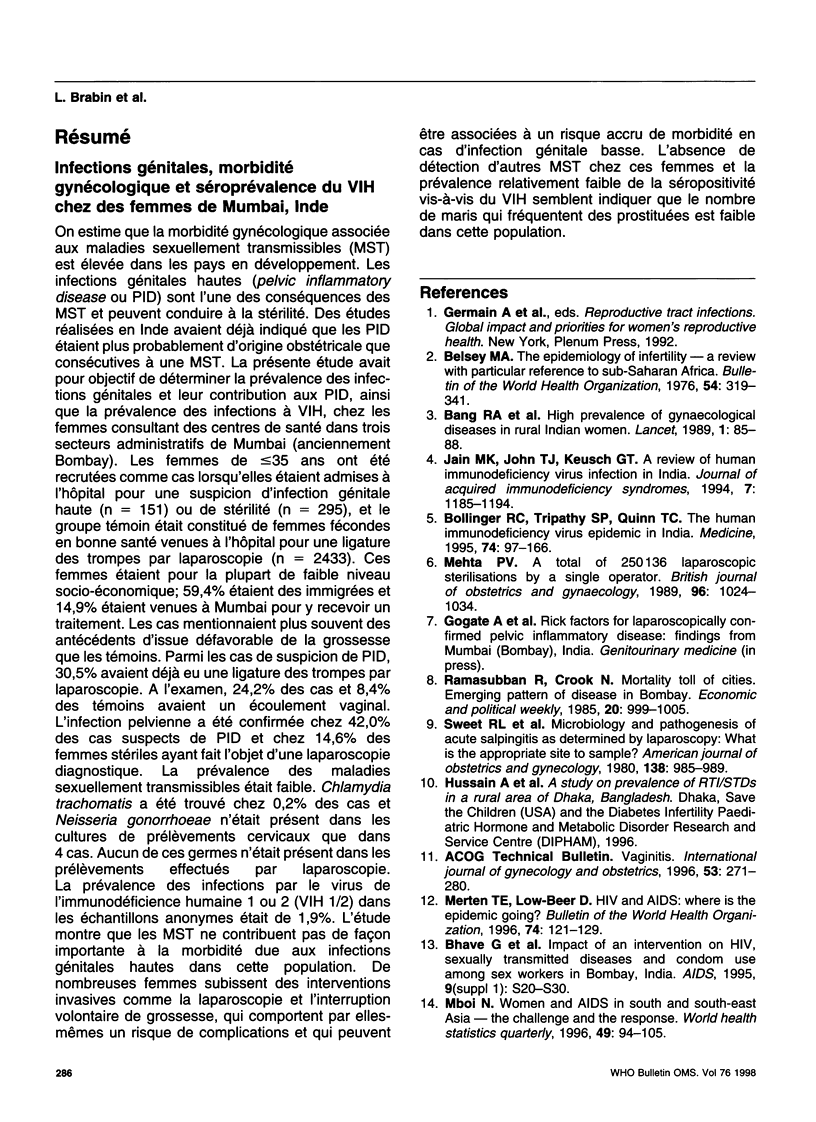
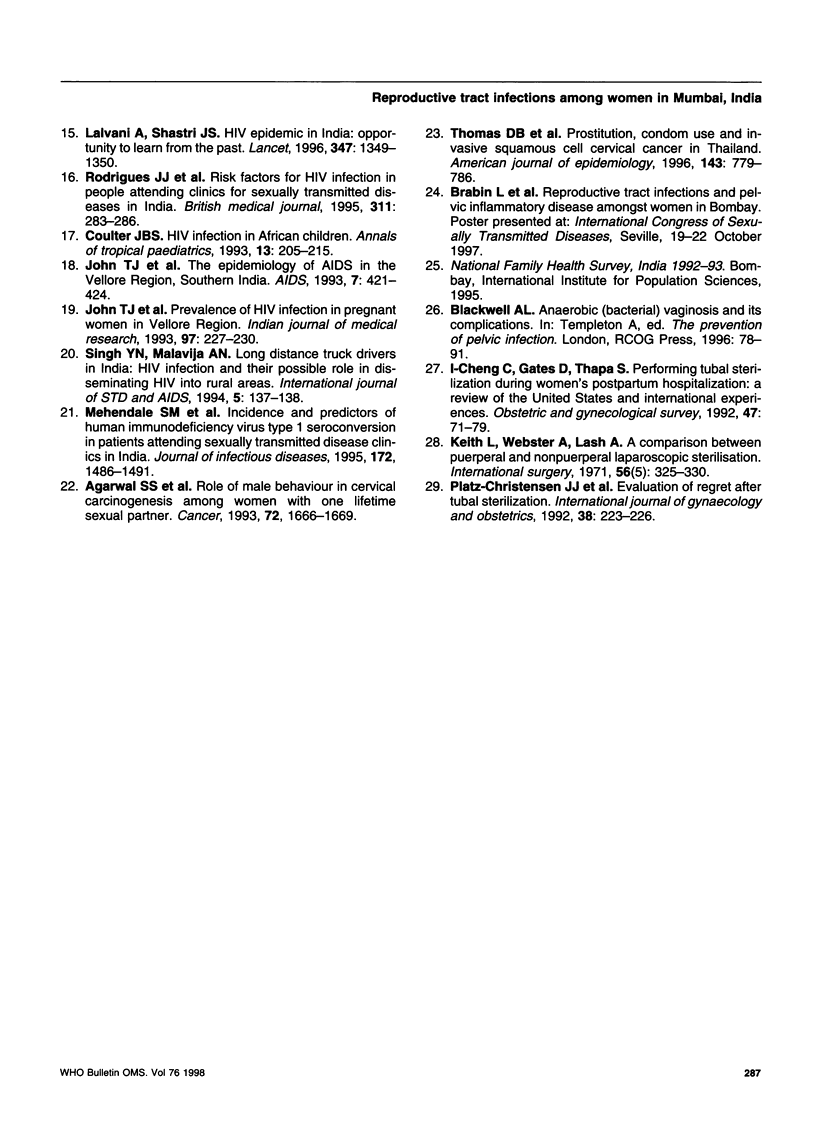
Selected References
These references are in PubMed. This may not be the complete list of references from this article.
- Agarwal S. S., Sehgal A., Sardana S., Kumar A., Luthra U. K. Role of male behavior in cervical carcinogenesis among women with one lifetime sexual partner. Cancer. 1993 Sep 1;72(5):1666–1669. doi: 10.1002/1097-0142(19930901)72:5<1666::aid-cncr2820720528>3.0.co;2-m. [DOI] [PubMed] [Google Scholar]
- Bang R. A., Bang A. T., Baitule M., Choudhary Y., Sarmukaddam S., Tale O. High prevalence of gynaecological diseases in rural Indian women. Lancet. 1989 Jan 14;1(8629):85–88. doi: 10.1016/s0140-6736(89)91438-4. [DOI] [PubMed] [Google Scholar]
- Belsey M. A. The epidemiology of infertility: a review with particular reference to sub-Saharan Africa. Bull World Health Organ. 1976;54(3):319–341. [PMC free article] [PubMed] [Google Scholar]
- Bollinger R. C., Tripathy S. P., Quinn T. C. The human immunodeficiency virus epidemic in India. Current magnitude and future projections. Medicine (Baltimore) 1995 Mar;74(2):97–106. doi: 10.1097/00005792-199503000-00005. [DOI] [PubMed] [Google Scholar]
- Chi I. C., Gates D., Thapa S. Performing tubal sterilizations during women's postpartum hospitalization: a review of the United States and international experiences. Obstet Gynecol Surv. 1992 Feb;47(2):71–79. doi: 10.1097/00006254-199202000-00001. [DOI] [PubMed] [Google Scholar]
- Coulter J. B. HIV infection in African children. Ann Trop Paediatr. 1993;13(2):205–215. doi: 10.1080/02724936.1993.11747647. [DOI] [PubMed] [Google Scholar]
- Jain M. K., John T. J., Keusch G. T. A review of human immunodeficiency virus infection in India. J Acquir Immune Defic Syndr. 1994 Nov;7(11):1185–1194. [PubMed] [Google Scholar]
- John T. J., Babu P. G., Saraswathi N. K., Jayakumari H., Selvaraj R., Kaur A., Chacko S., Jacob M., Ramachandran P., Tripathy S. P. The epidemiology of AIDS in the Vellore region, southern India. AIDS. 1993 Mar;7(3):421–424. doi: 10.1097/00002030-199303000-00018. [DOI] [PubMed] [Google Scholar]
- John T. J., Bhushan N., Babu P. G., Seshadri L., Balasubramanium N., Jasper P. Prevalence of HIV infection in pregnant women in Vellore region. Indian J Med Res. 1993 Nov;97:227–230. [PubMed] [Google Scholar]
- Keith L., Webster A., Lash A. A comparison between puerperal and nonpuerperal laparoscopic sterilization. Int Surg. 1971 Nov;56(5):325–330. [PubMed] [Google Scholar]
- Lalvani A., Shastri J. S. HIV epidemic in India: opportunity to learn from the past. Lancet. 1996 May 18;347(9012):1349–1350. doi: 10.1016/s0140-6736(96)91007-7. [DOI] [PubMed] [Google Scholar]
- Mboi N. Women and AIDS in south and South-East Asia: the challenge and the response. World Health Stat Q. 1996;49(2):94–105. [PubMed] [Google Scholar]
- Mehendale S. M., Rodrigues J. J., Brookmeyer R. S., Gangakhedkar R. R., Divekar A. D., Gokhale M. R., Risbud A. R., Paranjape R. S., Shepherd M. E., Rompalo A. E. Incidence and predictors of human immunodeficiency virus type 1 seroconversion in patients attending sexually transmitted disease clinics in India. J Infect Dis. 1995 Dec;172(6):1486–1491. doi: 10.1093/infdis/172.6.1486. [DOI] [PubMed] [Google Scholar]
- Mehta P. V. A total of 250,136 laparoscopic sterilizations by a single operator. Br J Obstet Gynaecol. 1989 Sep;96(9):1024–1034. doi: 10.1111/j.1471-0528.1989.tb03376.x. [DOI] [PubMed] [Google Scholar]
- Mertens T. E., Low-Beer D. HIV and AIDS: where is the epidemic going? Bull World Health Organ. 1996;74(2):121–129. [PMC free article] [PubMed] [Google Scholar]
- Platz-Christensen J. J., Tronstad S. E., Johansson O., Carlsson S. A. Evaluation of regret after tubal sterilization. Int J Gynaecol Obstet. 1992 Jul;38(3):223–226. doi: 10.1016/0020-7292(82)90132-1. [DOI] [PubMed] [Google Scholar]
- Rodrigues J. J., Mehendale S. M., Shepherd M. E., Divekar A. D., Gangakhedkar R. R., Quinn T. C., Paranjape R. S., Risbud A. R., Brookmeyer R. S., Gadkari D. A. Risk factors for HIV infection in people attending clinics for sexually transmitted diseases in India. BMJ. 1995 Jul 29;311(7000):283–286. doi: 10.1136/bmj.311.7000.283. [DOI] [PMC free article] [PubMed] [Google Scholar]
- Singh Y. N., Malaviya A. N. Long distance truck drivers in India: HIV infection and their possible role in disseminating HIV into rural areas. Int J STD AIDS. 1994 Mar-Apr;5(2):137–138. doi: 10.1177/095646249400500212. [DOI] [PubMed] [Google Scholar]
- Sweet R. L., Draper D. L., Schachter J., James J., Hadley W. K., Brooks G. F. Microbiology and pathogenesis of acute salpingitis as determined by laparoscopy: what is the appropriate site to sample? Am J Obstet Gynecol. 1980 Dec 1;138(7 Pt 2):985–989. doi: 10.1016/0002-9378(80)91093-5. [DOI] [PubMed] [Google Scholar]
- Thomas D. B., Ray R. M., Pardthaisong T., Chutivongse S., Koetsawang S., Silpisornkosol S., Virutamasen P., Christopherson W. M., Melnick J. L., Meirik O. Prostitution, condom use, and invasive squamous cell cervical cancer in Thailand. Am J Epidemiol. 1996 Apr 15;143(8):779–786. doi: 10.1093/oxfordjournals.aje.a008815. [DOI] [PubMed] [Google Scholar]


